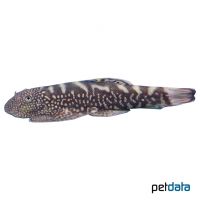Spiney-headed Hillstream Loach (Gastromyzon ctenocephalus)
| Spiney-headed Hillstream Loach Gastromyzon ctenocephalus | |
|---|---|
| Name | Spiney-headed Hillstream Loach |
| Name Lat. | Gastromyzon ctenocephalus |
| Family | Hillstream Loaches |
| Family lat. | Gastromyzontidae |
| Order | Carps |
| Order lat. | Cypriniformes |
| Origin | Southeast Asia |
| Habitat | Mountain streams |
| Diet | Limnivore |
| pH | 6.5-7.5 |
| Behavior | Peaceful |
| Keeping | Group |
| Care Level | Moderate |
| Reproduction | Egg scatterer |
| Breeding | Difficult |
| Life Span | 3-6 years |
| Protection | No |
| Metric Units | |
| Size | 4-5 cm |
| Temperature | 20-24 °C |
| Hardness | 2-12 °dH |
| Aquarium | 80 l |
| US Units | |
| Size | 1.6"-2" |
| Temperature | 68-75 °F |
| Hardness | 36-214 ppm |
| Aquarium | 20 gal |
Distribution and habitat
The range of the Sarawak fin sucker is tributaries of the Baleh and Rajang Rivers in Sarawak (Borneo). They live in fast-flowing, oxygen-rich mountain streams, often immediately before or after waterfalls, among rocks, boulders and round river pebbles densely covered with algae.
Maintenance
The aquarium should have robust planting, strong lighting, a substrate of sand and round-grained gravel, large rounded stones and roots (hiding places). They need oxygenated water and a strong current.
No ammonia, ammonium and nitrite should be detectable, the nitrate value should not exceed 100 mg/l. To ensure the water quality and oxygen content, a filter and heater adapted to the aquarium size is required, as well as lighting for the species-appropriate day-night rhythm of the animals.
Diet
They eat the plant cover (growth) of stones and wood and the microorganisms contained therein. For a balanced diet, feed them once a day with a high-quality sinking dry food (granules, tablets) as well as cyclops, daphnia or mosquito larvae (live or frozen). In addition, they need vegetable food, such as crushed peas, scalded spinach or algae leaves. It is recommended to coat stones or roots with a slurry of spirulina, chlorella and other algae powders and place them in the aquarium after they have dried. Only feed as much as will be eaten within a few minutes. A regular and varied diet promotes health and increases resistance.
Behaviour and compatibility
They are active and very peaceful fish that can be kept well with other peaceful fish, such as small barbs, and tetras. At least 5 Sarawak Fin Suckers should be kept together.
Basically, only compatible fish species with similar water condition and water temperature requirements should be socialized.
Sex dimorphism
Females are larger and plumper than males and have a more curved back.
Reproduction and breeding
They spawn over 100 small, transparent, in the middle cloudy, not adhesive eggs in the open water (free spawners), which sink to the bottom. After 3-4 days the fry hatch, which can take food only from the bottom.
Fry must be fed several times a day with special rearing food (e.g. infusoria, crushed food tablets). In a community tank breeding is hardly possible, because the spawn is easy prey.
Important
They have large pectoral and pelvic fins, which are formed as adhesive organs and with which they can attach themselves to stones in the fast-flowing waters. When changing location, they swim only short distances, fast and shallow over the bottom, to immediately suck themselves back in.
The well-being of the fish should be checked regularly. Temperature should be checked daily, pH, hardness and nitrate levels should be checked at least every 14 days. Regular partial water changes are recommended, even if the pollutant load has not yet reached the upper limit. Sudden changes in water quality should be avoided. Newly introduced fish must be accustomed slowly to the water in the aquarium.
Further literature can be found in your pet store.
References
Text: Werner Winter; Image: petdata
Source: BMELV (1998): Tierschutzgutachten - Haltung von Zierfischen (Süßwasser); ENGELMANN (2005): Zootierhaltung - Tiere in menschlicher Obhut: Fische, Verlag Harri Deutsch
- Gemäß § 21 Abs. 5 Tierschutzgesetz idgF
